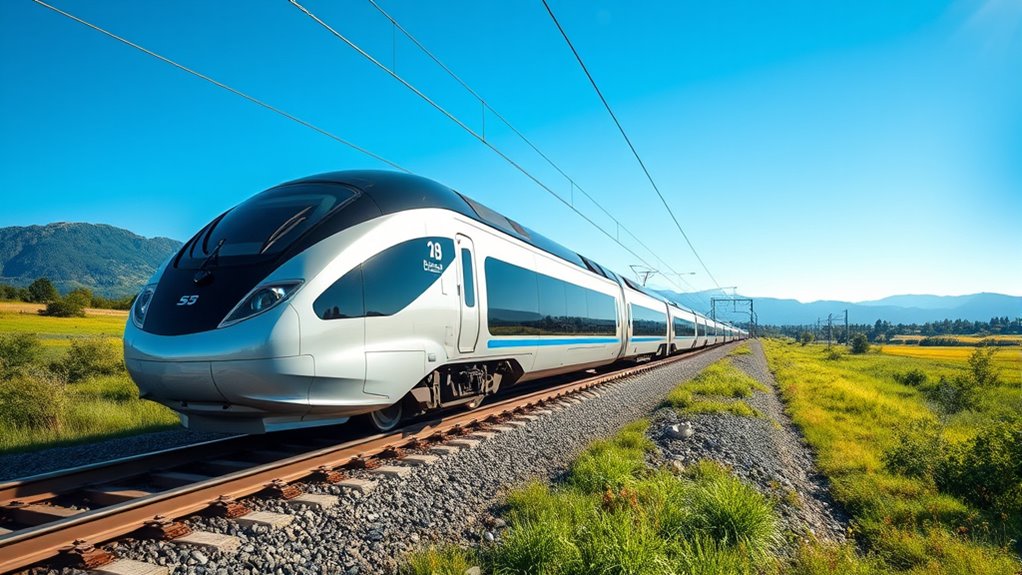Hydrogen trains are set to revolutionize rail travel with cutting-edge fuel cell technology that turns hydrogen into electricity, providing a cleaner and more efficient way to transport passengers. They produce zero emissions, helping you enjoy quieter rides while reducing air pollution. Supported by global initiatives and growing infrastructure, these trains promise longer ranges and faster refueling. Stay with us to explore how hydrogen trains could transform your journeys and reshape sustainable transportation.
Key Takeaways
- Hydrogen trains use fuel cell technology to convert hydrogen into electricity, enabling cleaner and quieter rail travel.
- They produce zero tailpipe emissions, significantly reducing air pollution and greenhouse gases.
- Global initiatives in countries like Germany, Japan, and South Korea are advancing hydrogen infrastructure and adoption.
- Innovations in storage and refueling increase range, efficiency, and operational reliability of hydrogen-powered trains.
- Challenges include high infrastructure costs and safety considerations, but future developments focus on urban integration and faster refueling.
The Technology Behind Hydrogen Trains

Hydrogen trains operate using a fuel cell system that converts hydrogen into electricity, powering the train’s electric motors. Recent fuel cell advancements have markedly improved efficiency and durability, making hydrogen trains more viable. These developments allow the fuel cells to operate reliably over long distances with minimal maintenance. Hydrogen storage is also essential; modern storage solutions use high-pressure tanks or liquefied hydrogen, ensuring safe and efficient containment of fuel onboard. Better hydrogen storage technologies increase the train’s range and make refueling quicker. Cost of Living Adjustments in fuel system design can further enhance performance and cost-effectiveness. Together, these innovations in fuel cell technology and hydrogen storage are transforming hydrogen trains into a practical, eco-friendly transportation option. As these technologies evolve, hydrogen trains are poised to become more widespread, offering cleaner alternatives to traditional rail systems.
Environmental Benefits and Sustainability
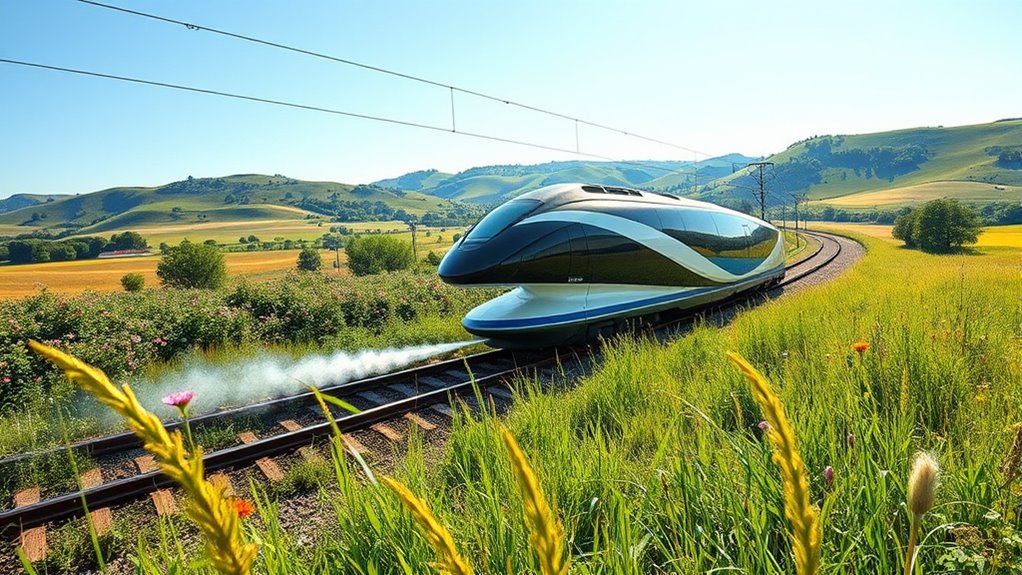
Because hydrogen trains produce zero tailpipe emissions, they substantially reduce air pollution and greenhouse gases compared to conventional diesel-powered trains. This makes them a vital tool in fighting climate change, as they help lower carbon footprints across rail networks. When hydrogen is produced using renewable energy sources, the environmental benefits multiply, creating a truly sustainable transportation option. Hydrogen trains emit only water vapor, which improves air quality in communities near rail lines. They also help reduce reliance on fossil fuels, supporting a transition toward cleaner energy systems. Additionally, dynamic communication exercises can foster better understanding and collaboration among stakeholders involved in implementing these technologies. By adopting these trains, you contribute to a greener future, helping to combat climate change and promote environmental sustainability. Overall, hydrogen trains offer a promising solution for more eco-friendly rail travel, aligning transportation with global climate goals.
Key Players and Global Initiatives
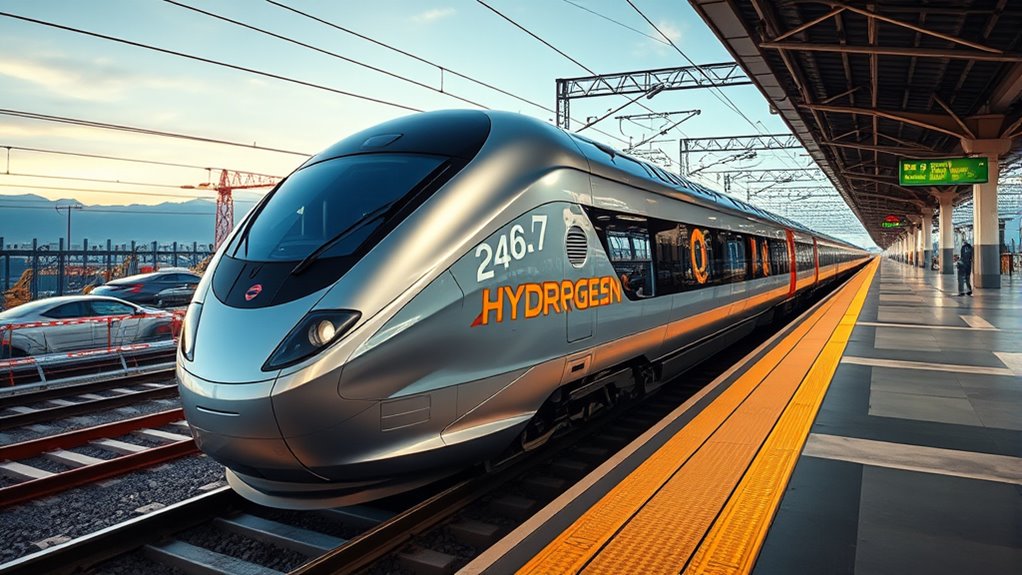
You’ll see which countries are leading the way in hydrogen rail development and how major industry collaborations are shaping the future. Government policies are also playing a vital role in accelerating adoption and innovation. Understanding these key players and initiatives helps you grasp the global momentum behind hydrogen trains. Additionally, fostering a creative practice mindset can accelerate breakthroughs in sustainable transportation solutions.
Leading Hydrogen Rail Countries
Which countries are currently leading the charge in hydrogen rail technology, and what global initiatives support their efforts? Germany, Japan, and South Korea stand out as pioneers, investing heavily in hydrogen infrastructure and fuel cell technology. These nations are deploying hydrogen-powered trains that reduce emissions and improve efficiency. Germany’s HyLIFT project, Japan’s Hydrogen Society Roadmap, and South Korea’s Hydrogen Economy Strategy showcase their commitment. They’re developing extensive fueling stations and integrating hydrogen trains into existing networks. International collaborations, such as the Hydrogen Council, foster innovation and knowledge sharing. Additionally, the adoption of natural techniques for sustainable infrastructure development is aiding their progress. These efforts not only advance hydrogen rail technology but also set global standards, encouraging other countries to follow suit. Their leadership is shaping the future of sustainable rail travel worldwide.
Major Industry Collaborations
Major industry collaborations play an essential role in advancing hydrogen rail technology by uniting key players and fostering innovation. These partnerships accelerate market expansion, enabling companies to share expertise and resources. By working together, industry leaders develop standardized solutions and scale production efficiently. Such collaborations also attract investment and customer confidence, pushing hydrogen trains closer to mainstream adoption. Strong technology integration is vital for overcoming the technical challenges inherent in hydrogen train development. These collaborations demonstrate how strategic alliances are pivotal for overcoming technical and market barriers, ensuring hydrogen trains become a sustainable and competitive transportation option worldwide.
Government Policy Support
Government policies and global initiatives are shaping the future of hydrogen trains by providing essential support and setting strategic frameworks. They play a pivotal role in accelerating adoption through policy incentives and funding strategies that reduce costs and encourage innovation. Governments worldwide are establishing clear targets for green transportation, offering subsidies, tax breaks, and grants to promote hydrogen infrastructure and train development. International collaborations are aligning standards and sharing best practices, making the technology more accessible. These efforts boost industry confidence, attract investments, and create a conducive environment for expansion. You’ll see governments actively fostering innovation through:
- Policy incentives like tax credits and rebates
- Funding strategies for infrastructure development
- Public-private partnerships
- Research grants for advanced technology
- International cooperation on standards
Adding these supportive measures enhances overall industry confidence and accelerates market adoption.
Challenges and Limitations

Despite the promising potential of hydrogen trains, several challenges and limitations hinder their widespread adoption. Cost challenges are significant; producing, storing, and maintaining hydrogen fuel systems require substantial investments, making initial deployment expensive. Additionally, infrastructure development for hydrogen refueling stations demands considerable resources and planning. Safety concerns also pose hurdles; hydrogen is highly flammable, and ensuring safe storage, handling, and operation is critical to prevent accidents. Public perception may be wary of using hydrogen due to these safety issues, slowing acceptance. furthermore, the current limited supply chain and high costs of hydrogen production, especially green hydrogen, add further obstacles. Overcoming these challenges will be essential to make hydrogen trains a viable, safe, and cost-effective alternative in rail travel. Research support also indicates that extensive testing and regulation are necessary to address safety concerns effectively.
Future Prospects and Developments
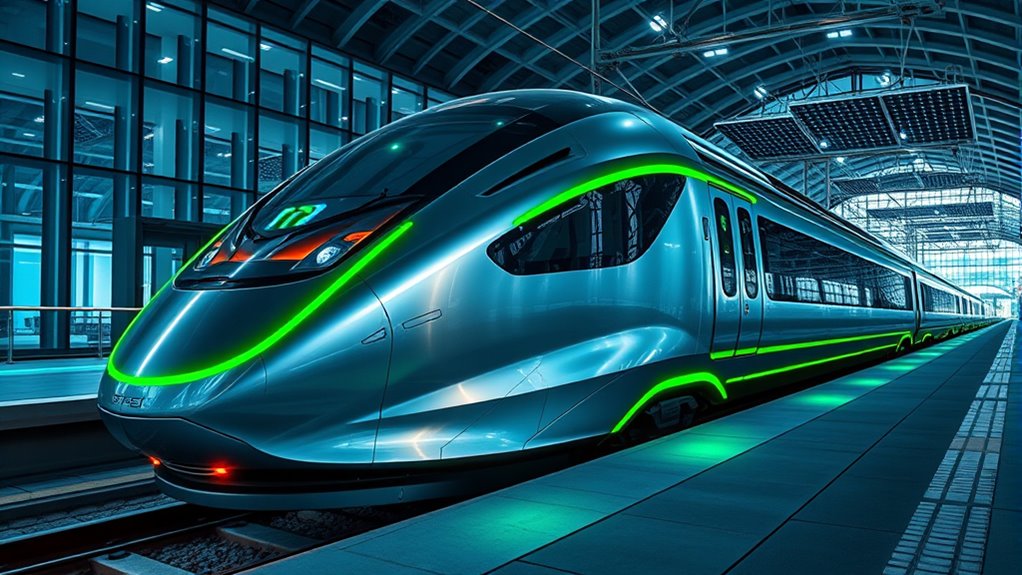
Advances in technology and growing environmental concerns are fueling optimism about the future of hydrogen trains. You can expect increased urban integration, making it easier to connect city centers with surrounding regions efficiently. Developments aim to improve passenger comfort through quieter engines and smoother rides, enhancing your travel experience. Innovations are also focused on expanding hydrogen refueling infrastructure, enabling wider deployment. Additionally, future trains may feature smarter systems for real-time monitoring and maintenance, reducing downtime. Here’s what’s on the horizon:
- Enhanced energy efficiency and longer range
- Streamlined urban station integration
- Improved interior design for passenger comfort
- Faster refueling times
- Greater adoption of renewable hydrogen sources
These advancements will make hydrogen trains more practical, eco-friendly, and comfortable for your daily commute or long-distance journeys.
How Hydrogen Trains Will Transform Rail Travel
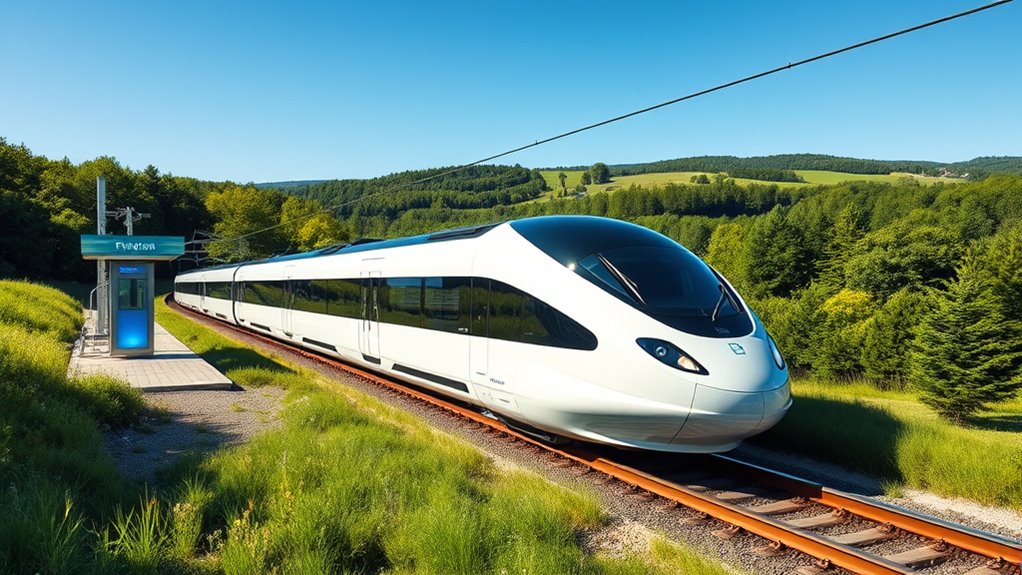
Hydrogen trains have the potential to drastically reduce emissions and improve environmental sustainability. However, developing the necessary infrastructure and ensuring reliable performance are key challenges to overcome. By addressing these factors, hydrogen trains can revolutionize rail travel with cleaner, more efficient transportation. A comprehensive understanding of cost management and the associated variances can further optimize operational efficiency in implementing these innovations.
Zero Emissions Benefits
Hydrogen trains are set to revolutionize rail travel by markedly reducing environmental impact, primarily through their zero emissions. By replacing diesel and electric trains reliant on fossil fuels, they help cut greenhouse gases and local air pollution. You’ll see benefits like cleaner air and a healthier environment. Plus, using renewable energy to produce hydrogen maximizes sustainability and reduces dependence on fossil fuels. The economic impacts are promising too — jobs in hydrogen production and train manufacturing will grow, boosting local economies. Here’s what you can expect:
- Significant reduction in carbon footprint
- Improved air quality in communities
- Enhanced sustainability through renewable energy sources
- New job opportunities in green industries
- Long-term cost savings for rail operators
Implementing sustainable energy practices in hydrogen production ensures these benefits are maintained over time. Hydrogen trains offer a cleaner, more sustainable future for rail travel.
Infrastructure Development Needs
To successfully implement hydrogen trains on a broad scale, substantial infrastructure development is essential. You’ll need new fueling stations, upgraded maintenance facilities, and updated urban planning to support hydrogen supply chains. This transformation will enhance the passenger experience by making stations more modern and efficient. Imagine a network where stations seamlessly connect, fueling stations integrated into urban landscapes, and trains that blend into city planning effortlessly. Incorporating sound healing science principles into station design could promote passenger relaxation during journeys.
Performance and Efficiency
As hydrogen trains come into service, they promise to revolutionize rail travel by offering superior performance and efficiency. Thanks to fuel cell advancements, these trains convert hydrogen into electricity more effectively, resulting in smoother acceleration and higher speeds. Their energy storage systems enable them to operate longer without refueling, increasing route flexibility. Here’s what makes them stand out:
- Increased energy efficiency compared to traditional diesel trains
- Faster acceleration and deceleration for better schedule adherence
- Lower emissions, reducing environmental impact
- Reduced noise levels, creating a quieter ride
- Greater operational reliability with improved fuel cell durability
Frequently Asked Questions
What Is the Estimated Cost of Implementing Hydrogen Train Infrastructure?
When you look into the cost estimation for hydrogen train infrastructure development, you’ll find it varies based on location and scale. You might expect significant investment in fueling stations, storage, and maintenance facilities. While initial costs are high, they could decrease over time with technological advancements and larger deployments. Overall, planning for infrastructure development involves considering these expenses carefully to guarantee a feasible shift to hydrogen-powered rail systems.
How Long Is the Typical Operational Lifespan of a Hydrogen Train?
You wonder about the typical operational lifespan of a hydrogen train. Generally, train longevity ranges from 25 to 35 years, depending on maintenance and usage. Hydrogen durability plays a key role, as the fuel cell systems are designed to last around 15,000 to 20,000 hours of operation, which usually spans multiple decades of service. Proper upkeep guarantees these innovative trains stay reliable throughout their lifespan.
Are There Safety Concerns Specific to Hydrogen Fuel in Trains?
You might wonder about hydrogen safety in trains, especially regarding fuel storage concerns. Hydrogen is flammable, but safety measures like robust containment systems and continuous monitoring reduce risks. Engineers design fuel tanks to withstand accidents, and strict regulations ensure safe handling. While fuel storage concerns are valid, advancements in safety technology and industry standards make hydrogen trains a secure and promising alternative, giving you confidence in their adoption.
How Do Hydrogen Trains Compare in Speed to Traditional Diesel and Electric Trains?
You’ll find that hydrogen trains match or even surpass traditional diesel trains in speed, thanks to their high hydrogen efficiency and quick train acceleration. Unlike electric trains, they don’t rely solely on overhead wires, offering flexible routes. While electric trains often have the edge in top speed, hydrogen trains provide a compelling mix of power and efficiency, making them a strong contender for future rail travel.
What Are the Maintenance Requirements for Hydrogen Fuel Cell Systems?
You need to regularly check the fuel cell durability and perform system diagnostics to keep hydrogen fuel cell systems running smoothly. Maintenance involves inspecting for leaks, monitoring the hydrogen storage, and replacing components as needed. You should also guarantee that the cooling system functions properly and that the system’s electrical connections are secure. Staying on top of these tasks helps prevent breakdowns and ensures the train operates efficiently and safely.
Conclusion
Hydrogen trains are poised to revolutionize rail travel, much like a gentle breeze transforming a stagnant pond. They offer a cleaner, sustainable alternative that could reshape how you commute, reducing emissions and reliance on fossil fuels. While challenges remain, the progress made hints at a future where your journeys are greener and more efficient. Embracing this technology is like planting a seed for a healthier planet—growing hope with every mile traveled.

